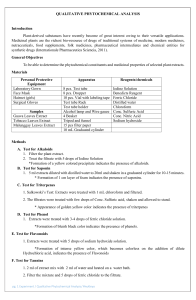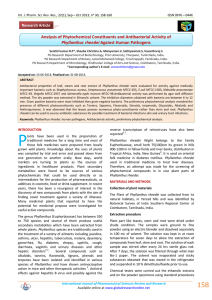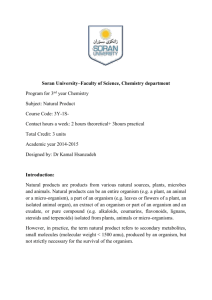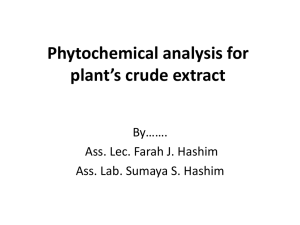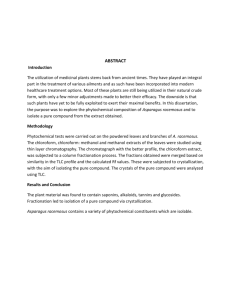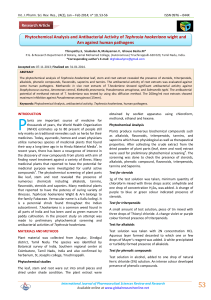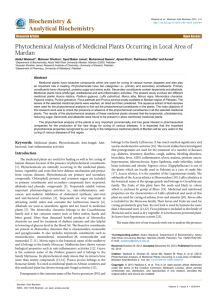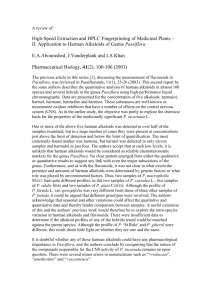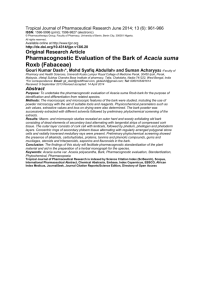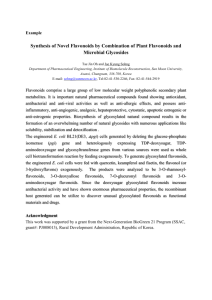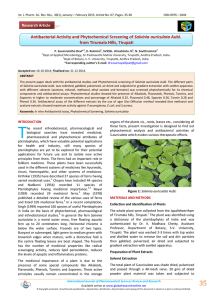Preliminary phytochemical analysis of some important
advertisement
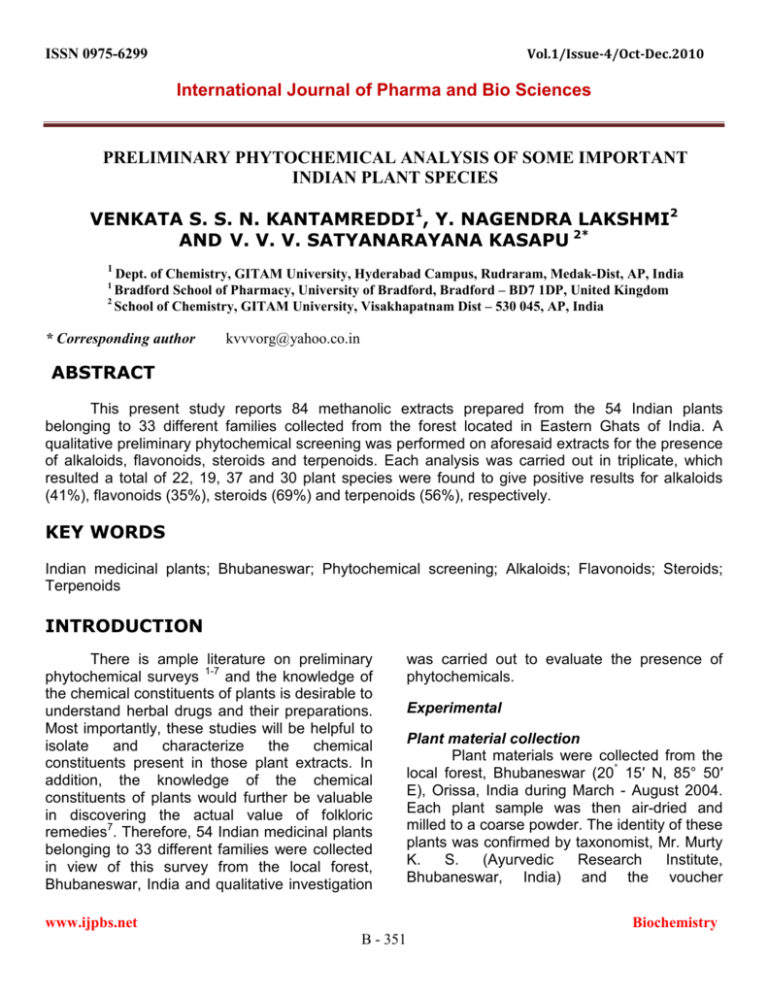
ISSN 0975-6299 Vol.1/Issue-4/Oct-Dec.2010 International Journal of Pharma and Bio Sciences PRELIMINARY PHYTOCHEMICAL ANALYSIS OF SOME IMPORTANT INDIAN PLANT SPECIES VENKATA S. S. N. KANTAMREDDI1, Y. NAGENDRA LAKSHMI2 AND V. V. V. SATYANARAYANA KASAPU 2* 1 Dept. of Chemistry, GITAM University, Hyderabad Campus, Rudraram, Medak-Dist, AP, India Bradford School of Pharmacy, University of Bradford, Bradford – BD7 1DP, United Kingdom 2 School of Chemistry, GITAM University, Visakhapatnam Dist – 530 045, AP, India 1 * Corresponding author kvvvorg@yahoo.co.in ABSTRACT This present study reports 84 methanolic extracts prepared from the 54 Indian plants belonging to 33 different families collected from the forest located in Eastern Ghats of India. A qualitative preliminary phytochemical screening was performed on aforesaid extracts for the presence of alkaloids, flavonoids, steroids and terpenoids. Each analysis was carried out in triplicate, which resulted a total of 22, 19, 37 and 30 plant species were found to give positive results for alkaloids (41%), flavonoids (35%), steroids (69%) and terpenoids (56%), respectively. KEY WORDS Indian medicinal plants; Bhubaneswar; Phytochemical screening; Alkaloids; Flavonoids; Steroids; Terpenoids INTRODUCTION There is ample literature on preliminary phytochemical surveys 1-7 and the knowledge of the chemical constituents of plants is desirable to understand herbal drugs and their preparations. Most importantly, these studies will be helpful to isolate and characterize the chemical constituents present in those plant extracts. In addition, the knowledge of the chemical constituents of plants would further be valuable in discovering the actual value of folkloric remedies7. Therefore, 54 Indian medicinal plants belonging to 33 different families were collected in view of this survey from the local forest, Bhubaneswar, India and qualitative investigation www.ijpbs.net was carried out to evaluate the presence of phytochemicals. Experimental Plant material collection Plant materials were collected from the local forest, Bhubaneswar (20° 15′ N, 85° 50′ E), Orissa, India during March - August 2004. Each plant sample was then air-dried and milled to a coarse powder. The identity of these plants was confirmed by taxonomist, Mr. Murty K. S. (Ayurvedic Research Institute, Bhubaneswar, India) and the voucher Biochemistry B - 351 ISSN 0975-6299 Vol.1/Issue-4/Oct-Dec.2010 specimens are kept available in the School of Pharmacy, University of Bradford, UK. Extraction A small scale extraction was carried out in view of preliminary bio-analysis. The dried pulverized plant material (1-5 g) was extracted with methanol at room temperature; the methanol was decanted after 24 hours and the extraction repeated three times. The pooled extracts were filtered and then concentrated under vacuum using a rotary evaporator at 40°C. Sample Preparation Crude extracts were prepared by weighing 5 mg approximately and dissolved with 1 ml of double distilled water. Later these solutions were diluted as per the requirement. Preliminary Phytochemical Analysis Qualitative phytochemical tests for the identification of alkaloids, flavonoids, steroids and terpenoids were carried out for all the extracts by the method described by Harborne (1998) and Sazada et al (2009). These tests were carried out in triplicate using various concentrations of sample. Test for Alkaloids A small portion of crude extract was dissolved in 5ml of 1% hydrochloric acid, filtered and tested with Dragendorff’s reagent and Mayer’s reagent separately. Any precipitate or turbidity with the reagents suggests the presence of alkaloids. Test for Flavonoids A few drops of conc. hydrochloric acid and 1-2 magnesium turnings were added to 1 ml of methanolic extract. The presence of flavonoids was indicated by the development of pink or www.ijpbs.net magenta-red colour. Test for Steroids and Terpenoids A small portion of extract was dissolved in 1ml of chloroform and filtered. To the filtrate on ice, 1 ml of acetic acid was added and then a few drops of conc. sulphuric acid were run down the side of the test tube. The appearance of a pink or pinkish-brown ring / colour indicates the presence of terpenoids. The appearance of blue, bluish-green or a rapid change from pink to blue colours indicates the presence of steroids and a combination of pink and these colours indicates the presence of both steroids & terpenoids. RESULTS AND DISCUSSION Our approach involved the collection, identification, extraction and phytochemical evaluation of extracts derived from commonly occurring native plants growing in the Eastern Ghats region of India. In this study, 54 plant species belonging to 33 different families were collected. Most of these plants were reported to treat a variety of diseases in traditional system medicine (9-12). Local names (in Oriya) of these plant species and their voucher specimen numbers were recorded in Table 1. Eighty four methanolic extracts were prepared from various parts of plants such as bark, bud, heartwood, flower, fruit, leaf, pulp, root, seed, stem and in some cases the whole plant materials were used belonging to 54 plants. The preliminary phytochemical screening for the presence of alkaloids, flavonoids, steroids and terpenoids was carried out on aforesaid extracts and the results are reported in Table1. Biochemistry B - 352 ISSN 0975-6299 Family name Species name Vol.1/Issue-4/Oct-Dec.2010 Table 1 List of plant species collected with their local names (in Oriya) and phytochemical results. Family name Part Phytochemical Screening (Specimen No.) Alkaloid Flavanoid Steroid Terpenoid Acanthaceae Crossandra infundibuliformis L. Kankambarum (040716) Rt − − − + Ankul (040801) Bk + − − + Raji-mohi (040713) Bk − + − + Bhalia (040412 & 13) Bk Lf + − − − + + + − Gandha palasa (040310 - 12) Bk Ft Lf − − − − − − + + + − − − Holarrhena antidysenterica (Roth.) Wall.ex A.DC. Kherwa (040710) Bk + − − + Asclepiadaceae Pergularia daemia Chiov. Utrail (040501 - 03) Lf Rt St − − − − − − + + + − + + Mayurchulia (040707 & 08) Bui kadanb (040701) Lf Rt Wp − − + − + + + + + + + − Hinjal (040706) (040702 & 03) Hw Rt Bk Rt Hw − − − + − − − − − + + + Gondhrilata (040414) Wp − − + − Kekar (040512) Fl − − + − Anogeissus acuminata (Roxb.ex Phansi DC.) Guill&Perr. (040602) Bk + + + + Calycopteris floribunda (Roxb.)Poir. Lf − − + + Alangiaceae Alangium lamarckii Thw. Anacardiaceae Lannea coromandelica (Houtt.)Merr. Semecarpus anacardium L. Annonaceae Miliusa tomentosa (Roxb.)Sinclair Apocynaceae (Forsk) Asteraceae or Compositae Elephantopus seaber L. Sphaeranthus indicus L. Barringtoniaceae Barringtonia acutangula L. Boraginaceae Coldenia procumbens L. Burseraceae Bursera serrata Wall. ex Colebr. Combretaceae Atundi (040704) www.ijpbs.net Biochemistry B - 353 ISSN 0975-6299 Vol.1/Issue-4/Oct-Dec.2010 Family name Species name Family name (Specimen No.) Part Combretum roxburghii Spreng. Kala Atundi (040705) Rt Jhanjika (040603 - 05) Bk Hw Lf Bk − − − + Euphorbiaceae Breynia vitis-idaea (Burm.f.) Fischer Phytochemical Screening Alkaloid − Flavanoid + Steroid − Terpenoid + + + − + + − + + + + − − Phyllanthus emblica L. Amla / Anola (040309) Phyllanthus reticulatus Poir. Jandaki (040409-11) Bk Hw Lf + + − − − − − − + + + + Krishnachura (040601) Lf − − + + Ban tulasi (040711) Rt − − − + Leucas plukeneti Gaiso / Gobo (040802) Wp − + + − Ocimum canum Sims Gonga tulasi (040714) Lf − − − + Nirmuli (040608 & 09) Ft Lf − − + − + + − − Kumbhi (040513 & 14) Bk Lf − − − − + + − + Bado chakunda (040313) Lf + + + − Cassia obtusifolia L. Chakunda (040301) Wp + − + − Pueraria tuberose (Willd.)Dc. Bhui kakharu (040515) Rt + − − + Madang (040415) Lf − + + − Dhatuki (040720) Lf − − + + Fabaceae Caesalpinia pulcherrima (L.) Swart. Lamiaceae Hyptis suaveolens L. Lauraceae Cassytha filiformis L. Lecythidaceae or Myrtaceae Careya arborea Roxb. Leguminoceae Cassia hirsuta L. Loranthaceae Loranthus longiflorus L. Lythraceae Woodfordia floribunda Salisb www.ijpbs.net Biochemistry B - 354 ISSN 0975-6299 Family name Species name Vol.1/Issue-4/Oct-Dec.2010 Family name (Specimen No.) Part Phytochemical Screening Alkaloid Magnoliaceae Magnolia champaca (L.) Baill. ex Pierre Malvaceae Abutilon indicum (L.) Sweet Meliaceae Cipadessa baccifera (Roth.)Miq. Soymida febrifuga (Roxb.)A.Juss. Mimosaceae Mimosa pudica L. Moraceae Ficus hispida L.f. Streblus asper Lour. Oleaceae Nyctanthes arbor-tristis L. Oxalidaceae Oxalis corniculata L. Papaveraceae Argemone mexicana L. Rhamnaceae Ziziphus jujuba L. Rubiaceae Pavetta crassicaulis Bremek Tarenna zeylanica Gaertn Rutaceae Chloroxylon swietenia DC. Glycosmis pentaphylla (Retz.)DC. Flavanoid Steroid Terpenoid Champa (040405 - 08) Bd Fl Ft Pl Sd − − + − + + + + + + + + + + + + Pedi-pedika (040314) Rt + − + + Pittamari (040610) Lf + − + − Rohini (040718) Bk − + − + Lajakuli (040803) St − − + + Dimiri (040507) Ft + − − + Sahada (040611) Lf − − − + Gangaseoli (040607) Lf − − + − Ambiliti (040715) Wp − − − + Agara (040315) Rt + − + − Barakuli (040403 & 04) Rt Bk Rt Hw − − − − − − + + Kuku-chalia (040612 & 13) Jajanka (040319 & 20) Ft Lf Fl Lf − + − + − − − − + + + + + − − + Bheru / Bherua (040614 & 15) Lankabadam (040417 & 18) Bk Lf Ft Lf − + + + + − − − + + + + − − − − www.ijpbs.net Biochemistry B - 355 ISSN 0975-6299 Vol.1/Issue-4/Oct-Dec.2010 Family name Species name Family name (Specimen No.) Part Murraya exotica L. Ban mallika (040606) Rt Naringi crenulata (Roxb.) Nicolson Benta / Bhenta (040419 & 20) Tundpora (040416) Fl Lf Lf Kusum (040717) Phytochemical Screening Flavanoid − Steroid − Terpenoid + + − − − − + + + + − − − Bk − + − + Badichang (040316 - 18) Fl Lf St − − − − − − + + + − − − Nagri (040306 & 08) Gambari (040709) Fl Lf Rt + + − − − − + + + − − + Lantana camara L. var aculeate (L.) Moldenke Nagaboiri (040712) Lf − − − + Vitex negundo L. Begunia (040504) (040508 - 11) Vitex pinnata L. Majurgudia (040719) Bk Fl Hw Lf Rt Lf − − − − − − − + − − − + − + − + + + + + + + + + Toddalia asiatica (L.) Lam. Sapindaceae Schleichera oleosa (Lour.) Oken. Symphorematacea Symphorema polyandrum Wight Verbenaceae Clerodendrum indicum (L.)Kuntze Gmelina arborea Roxb. Alkaloid + Bk: bark, Bd: bud, Hw: heartwood, Fl: flower, Ft: fruit, Lf: leaf, Pl: pulp, Rt: root, Sd: seed, St: stem and Wp: whole plant (+) Indicate the presence of phytochemicals and (−) Indicate the absence of phytochemicals Of the investigated plants, a total of 25 (30%), 23 (27%), 59 (70%) and 50 (60%) extracts belonging to 22 (41%), 19 (35%), 37 (69%) and 30 (56%) plants were found to give positive results for alkaloids, flavonoids, steroids and terpenoids, respectively. Interestingly, the plants belonging to all families tested were given maximum positive indications for terpenoids and steroids, but only 50% of plants belonging to families showed the presence of alkaloids and flavonoids. This obtained information will be helpful as a primary platform for further phytochemical and pharmacological studies. The extracts belonging to the following species listed below given positive indication for alkaloids, flavonoids, steroids and terpenoids, respectively. Alkaoids Anogeissus acuminata, Abutilon indicum, Argemone mexicana, Alangium lamarckii, Cipadessa baccifera, Cassia hirsuta, Cassia obtusifolia, Clerodendrum indicum, Chloroxylon www.ijpbs.net Biochemistry B - 356 ISSN 0975-6299 Vol.1/Issue-4/Oct-Dec.2010 swietenia, Ficus hispida, Glycosmis pentaphylla, Holarrhena antidysenterica, Magnolia champaka, Murraya exotica, Naringi crenulata, Pavetta crassicaulis, Phyllanthus emblica, Phyllanthus reticulatus, Pueraria tuberose, Semecarpus anacardium, Sphaeranthus indicus and Tarenna zeylanica. Favanoids Anogeissus acuminata, Barringtonia acutangula, Breynia vitis-idaea, Cassytha filiformis, Cassia hirsuta, Combretum roxburghii, Chloroxylon swietenia, Elephantopus seaber, Lannea coromandelica, Loranthus longiflorus, Leucas plukeneti, Magnolia champaka, Phyllanthus emblica, Sphaeranthus indicus, Schleichera oleasa, Soymida febrifuga, Toddalia asiatica, Vitex negundo and Vitex pinnata. Steroids Anogeissus acuminata, Abutilon indicum, Argemone mexicana, Bursera serrata, Breynia vitisidaea, Careya arborea, Cipadessa baccifera, Cassytha filiformis, Calycopteris floribunda, Cassia hirsuta, Clerodendrum indicum, Caesalpinia pulcherrima, Coldenia procumbens, Cassia obtusifolia, Chloroxylon swietenia, Elephantopus seaber, Gmelina arborea, Glycosmis pentaphylla, Loranthus longiflorus, Leucas plukeneti, Magnolia champaka, Mimosa pudica, Miliusa tomentosa, Nyctanthes arbor-tristis, Naringi crenulata, Pavetta crassicaulis, Pergularia daemia, Phyllanthus emblica, Phyllanthus reticulatus, Semecarpus anacardium, Sphaeranthus indicus, Symphorema polyandrum, Toddalia asiatica, Tarenna zeylanica, Vitex negundo, Vitex pinnata and Woodfordia floribunda. Terpenoids Anogeissus acuminata, Abutilon indicum, Alangium lamarckii, Barringtonia acutangula, Breynia vitis-idaea, Careya arborea, Calycopteris floribunda, Crossandra infundibuliformis, Caesalpinia pulcherrima, Combretum roxburghii, Elephantopus seaber, Ficus hispida, Gmelina arborea, Holarrhena antidysenterica, Hyptis suaveolens, Lantana camara, Lannea coromandelica, Magnolia champaka, Mimosa pudica, Murraya exotica, Ocimum canum, Oxalis corniculata, Pavetta crassicaulis, Pergularia daemia, Phyllanthus reticulatus, Pueraria tuberose, Semecarpus anacardium, Streblus asper, Schleichera oleasa, Soymida febrifuga, Tarenna zeylanica, Vitex negundo, Vitex pinnata, Woodfordia floribunda and Ziziphus jujuba. ACKNOWLEDGEMENTS V. S. S. K expresses his gratitude to the Association of Commonwealth Universities, UK for financial support received (Commonwealth Scholarship Reference No.: INCS-2004-144). REFERENCES (1) S.Sazada, A.Verma, A.A.Rather, F.Jabeen and M.K. Meghvansi. Preliminary phytochemicals analysis of some important medicinal and aromatic plants. Adv. in Biol. Res., 3, 188-195 (2009). (2) F.Mojab, M.Kamalinejad, N.Ghaderi and H.R.Vahidipour. Phytochemical Screening of www.ijpbs.net Some Species of Iranian Plants. Iran. J. Pharm. Res., 77-82 (2002). (3) S.J.Somolenski , H.Silinis and N.R.Farnsworth. Alkaloid screening. V. Lloydia., 37, 506-536 (1974). (4) M.H.Salehi Surmaghi, Y.Aynehchi, G.H.Amin and Z.Mahmoodi. Survey of Iranian plants for saponins, alkaloids, Biochemistry B - 357 ISSN 0975-6299 Vol.1/Issue-4/Oct-Dec.2010 flavonoids and tannins. IV. Daru., 2, 281291(1992). (5) A.M.Rizk. Constituents of plants growing in Qatar. I. A chemical survey of sixty plants. Fitoterapia., 52, 35-44 (1982). (6) L.D.Kapoor, A.Singh , S.L.Kapoor and S.N.Srivastava, Survey of Indian plants for saponins, alkaloids and flavonoids. I. Lloydia., 32, 297-304 (1969). (7) N.R.Farnsworth, Biological and phytochemical screening of plants, J. Pharm. Sci., 55, 225276 (1966). (8) J.B.Harborne (eds.). Phytochemical Methods: A guide to modern techniques of plant analysis. 3rd ed. Chapman and Hall, London ISBN: 0-412-57270-2, 302 (1998). (9) S.P.Ambasta, K.Ramachandran, K.Kashyapa and R.Chand (eds.) The useful plants of India. www.ijpbs.net Council of Scientific & Industrial Research: New Delhi, India (1992). (10) R.N.Chopra, S.L.Nayar and I.C.Chopra (eds.) Glossary of Indian medicinal plants. Council of Scientific & Industrial Research: New Delhi, India (1956). (11) V.S.S.Kantamreddi, S.Parida, S.M.Kommula and C.W.Wright. Phytotherapy used in Orissa state, India for treating malaria. Phytotherapy Res., 23 (11), 1638 – 1641 (2009). (12) P.K.Warrier, V.P.K.Nambiar, C.Ramankutty (eds.) Indian medicinal plants. Orient Longman: Chennai, India (1995-1997). Biochemistry B - 358
